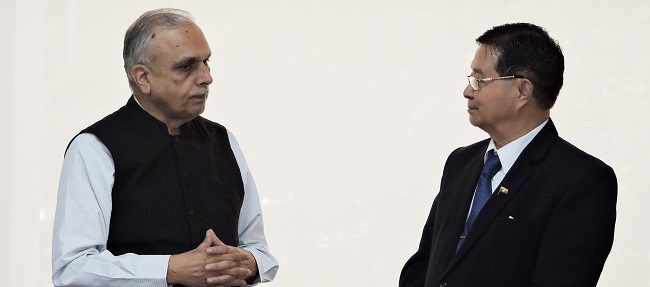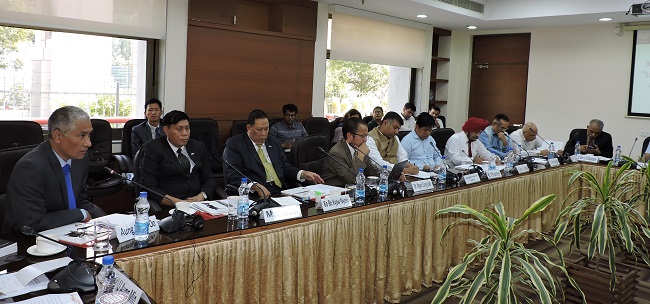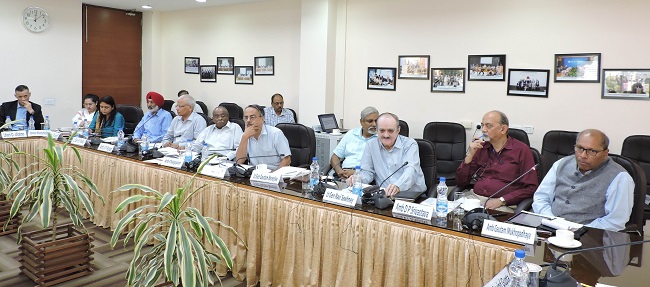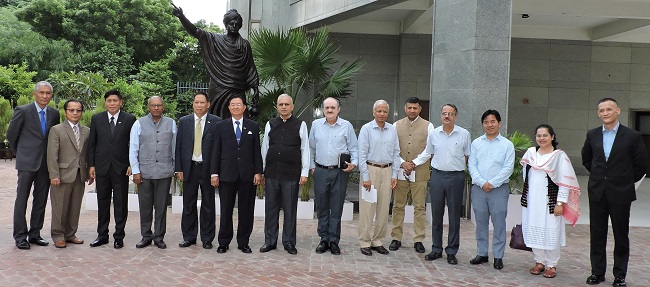The Vivekananda International Foundation (VIF) organised an interaction with a Myanmar delegation led by Gen. U Aung Min and comprising of five other members of Peace Development Foundation of Myanmar. Gen. U Aung Min, formerly a Minister and Chief Negotiator with Myanmar's Ethnic Armed Organisations, and his colleagues had very ably guided the Myanmar Peace Process till the current government came to power. The delegation members interacted with the VIF faculty on India-Myanmar relations and the way forward. China factor in India-China relations, current status of Myanmar’s peace process and activities of insurgent groups along the Indo-Myanmar border were the subjects that were in focus.
The Myanmar delegation highlighted the fact whenever any discussions take place China is the big elephant in the room. When the West puts pressure on Myanmar it runs into the arms of China; that is very much happening again. Myanmar does not want to become a peripheral province of China. To balance Chinese influence, India plays an important part thus the significance of bilateral relationship. China’s OBOR initiative was described as nothing but monopolising of the economic and strategic narratives. Through its infrastructure activities like the development of Kyaukpyu deep water port on Arakan coast and proposed high speed railway line project, it has been able to get a gateway to the Indian Ocean region. Following good corporate governance and ethical policies are not the strong points of Chinese companies, the visitors averred.

It was stated that the Tatmadaw has been relying on Russian military, not just on the Chinese. Mayanmar needed India for defence equipment, weapon systems and military aid to modernise its armed forces with better coordination and understanding from India. Cooperation in high technology areas like space etc. were also needed; while India was seen as a balancer against China and as a big brother.
In so far as Myanmar Peace process was concerned it was not going well. The process is bureaucratic and government-military relations are not up to the mark. There are worries that Nationwide Ceasefire Agreement (NCA) may collapse. There is a need for frequent meetings with the leadership to discuss the scope and structure of the process as also to reconcile different interpretations. Overall aim is to restore trust and faith in the process. China has become critical partner in the peace process; it has extended some help in bringing Northern Alliance groups for the Panglong Conference though they have not joined the NCA. China says that its OBOR projects will help in bringing peace. China has great influence on United Wa State Army (USWA), Kachin Independence Army (KIA) and rebel other groups that are members of Northern Alliance (NA); it has supplied weapons and other military equipment to them. As is well-known, Chinese weapons find their way across to insurgent groups in India and Bangladesh. Thus China’s help is needed.

The delegation further stated that Myanmar needed to cooperate in socio-economic development of Nagas on both sides. Further, in case of Chin National Front (CNF), if the peace process collapses then CNF might run back to find shelter in India. Therefore, India has to encourage CNF to support the NCA and peace process. There are problems of the Arakan Army (AA) and the Rohingyas too. AA was formed as a nationalist movement because of poverty and inequality. Some leaders of AA are living in Mizoram and they use their bases for recruitment from Rakhine refugees there. They could pose threat to the Kaladan Project.
The VIF Faculty highlighted the following:-
It was well recognised that the Gen U Aung Min and other members of the team had taken many personal risks during their tenure to push forward the peace process in Myanmar. They had been successful in getting eight Ethnic Armed Organisations (EAO) to sign the NCA.
Democratic opening in Myanmar allows us to have much freer relations with the whole spectrum of Myanmar society, state and regions, political parties, civil society, citizen organisations. India needs to enhance its engagement with NGOs and Myanmar civil society.
We need to establish contacts with EAOs; Gen. U Aung Min can help us in this regard. This has to be done informally; such contacts could be helpful for the peace process. Evidently, India stands for integrity of Myanmar and this would not in any way be against the national interest of Myanmar.

India’s presence in Myanmar is lacking, especially in the business and economy areas. China is a factor in geopolitics and our bilateral relationship. We cannot match the scale and scope of China in infrastructure, manufacturing and trade or compete with them in financial strength. Our bilateral trade is limited, it needs to be raised to 10 billion USD. We need to invest more in areas of tourism, real estate and other sectors. There is need for strategic investment in high tech areas, agriculture, horticulture, micro-industry; we could establish a SME, MSME corridor from North East India through Myanmar which could go up to Vietnam with industrial clusters along the way chain-linked together.
India and Myanmar need to further strengthen defence and security cooperation. On the question of Rohingyas, Myanmar is most likely willing to give citizenship rights under the 1983 Act but not under the category of separate ethnic entity as Rohingya. We need to test it. A large number of Rohingyas in Bangladesh, outside the purview of Myanmar Government have the potential of being exploited by the radical elements thus impacting the regional security adversely. Return of Rohingyas back to Myanmar with citizenship rights should be facilitated.

When Khaplang died last year it was hoped that the National Socialist Council of Nagaland- Khaplang (NSCN-K) will join the peace process. On the other hand, they have been carrying out operations against the Indian security forces. NSCN (K) has also been offering shelter to other insurgent groups from India. We need to cooperate further on these aspects.
Insofar as the CNF is concerned, it has signed NCA with Myanmar, and at present is considerably weakened. While Mizoram has three or four refugee camps for 1600 to 1700 Myanmar people who have fled last year from Paletwa area of Chin State bordering the Rakhine State, there are no reports of the AA recruiting some personnel from these refugees. Presence of AA elements in Paletwa also has adverse security implications for construction of road from Paletwa to Mizoram border as part of the ongoing multi-modal Kaldan Project. Therefore, we need to keep a continuous watch on the activities of insurgent groups and enhance our cooperation on security issues.
After the presentations by both sides there was an elaborate question and answer session.



Post new comment